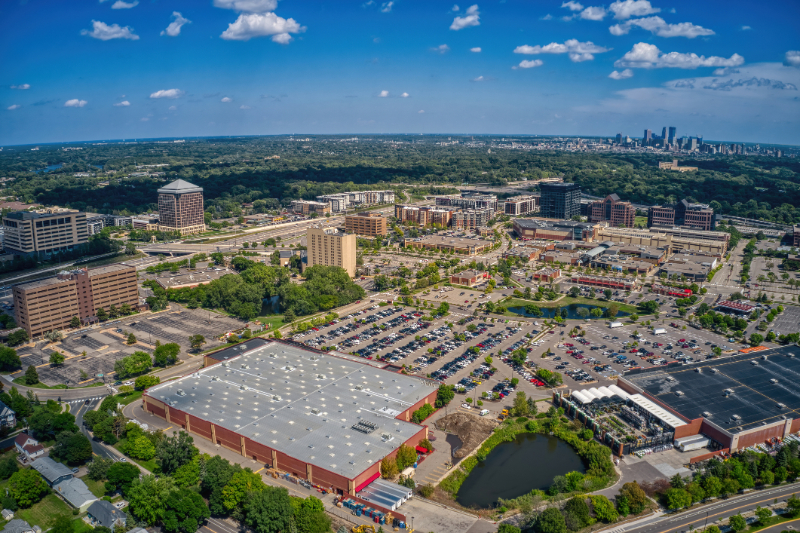
Looking for homes for sale in the North Star State to use as your primary home or as a real estate investment? With its sprawling green spaces balanced with urban comforts and a business-friendly environment, you can’t go wrong with St. Louis Park, MN.
Given its relatively short distance (approximately 12 miles west) from the Twin Cities of Minneapolis and St. Paul, St. Louis Park is considered part of the greater Minneapolis-St. Paul metropolitan area. But what distinguishes SLP is its residents’ dedication to preserving the natural environment, which is why this suburban city flourishes with its lovely parks, nature trails, and numerous options for outdoor recreation.
Learn more about St. Louis Park, MN and the most efficient methods for successfully purchasing one of the homes for sale here in the next sections below.
Table of Contents:
BRIEF OVERVIEW OF ST. LOUIS PARK, MN

Covering more than 10 square miles, St. Louis Park is quite small in terms of land area. But around 50,000 individuals call it home. A large segment of the population is composed of young, educated professionals who found the city’s economic atmosphere to be perfect for starting a business or a career.
Known for its peaceful environment, diversity in many aspects, an ever-growing economy, and easy access to the Twin Cities’ amenities and attractions, it is no surprise that the city’s real estate market is booming!
Real estate scene
In the past three years, home values in SLP experienced momentary spikes and dips but never went below the $300,000 base price. The range went from around $315,000 to $405,000. Luxury homes in the area could be sold for as high as $1.35 million. Overall, the market is a highly competitive one where properties are quickly snagged as soon as they’re put on sale, only lagging once when the Fed first hiked interest rates post-pandemic in January 2023.
Housing market
SLP features a diverse set of real estate options, including historic homes, industrial properties, apartment complexes and other forms of multi-family housing, condos, single-family homes, waterfront residences, and grand mansions.
It must also be noted that many of the homes here were built around the 1940s, which is why common home designs are in traditional architectural styles. These include Queen Anne, Tudor Revival, Cape Cod, Mid-century Modern, Colonial Revival, Craftsman, and Prairie School. More recent construction in the city sport modern design influences.
Many of the houses in SLP usually come with two to three bedrooms and are fitted with smart technology that allows homeowners to save on utility bills and contribute to sustainability efforts of the city.
ZILLOW FOR THE SLP HOME SEARCH: A GOOD IDEA?
Whether it’s homes for sale in St. Louis Park MN, or any other place for that matter, a common practice for many buyers would be to begin their search on real estate website, Zillow – given its huge popularity. With just a few clicks, Zillow allows the general public to browse through various properties and their respective market values (what Zillow calls “Zestimates”) in virtually any area of the country. Its income primarily comes from selling ad space and leads to agents and brokers.
While the said platform does help in giving buyers an idea of what’s out in the market and the amount of budget to prepare, agents, brokers, and more seasoned buyers note that there are also some downsides to depending too much on Zillow in the home-buying process.
WHERE ZILLOW FALLS SHORT

Here are instances where reliability becomes a question with listings on Zillow:
-
Listings are not representative of all homes for sale in St. Louis Park MN (or anywhere, for that matter)
According to Zillow, it also sources its data from the Multiple Listing Service. The MLS is supposed to be a local database of all for-sale properties from brokers but it is still the brokers’ discretion if they wish to merge their feeds with Zillow’s. Some don’t do so, as they may have clients who want to keep the process of selling their homes under wraps. Called offline listings, these homes cannot be found on Zillow or on any other real estate listing. Transactions of this nature are done through networks where industry colleagues pass information about an offline listing among themselves and their respective clients.
Additionally, there are brokers who prefer not to upload units for rent on Zillow through their respective accounts. Thus, it’s not uncommon for rental properties in some areas to be few and far between.
-
Outdated listings
Zillow chiefly obtains listings through manual submissions by brokers or agents with Zillow accounts. If, for some reason, the broker or agent is not able to update a listing’s status after it’s sold, the old listing remains unchanged. Hence, the case of outdated ones.
As of writing, Zillow’s St. Louis Park for-sale listings amount to 100 but, as with other counties or towns, this does not reflect the real number on the ground. Thus, it’s common to see properties tagged as “active” on the website but are actually no longer available or have been placed under a different agent.
-
Wrong pricing and inaccurate estimates of market values
A “Zestimate” is Zillow’s method for deriving a property’s perceived value. According to the Zillow website, the Zestimate “incorporates public, MLS, and user-submitted data into Zillow’s proprietary formula, also taking into account home facts, location and market trends.”
Zillow’s Zestimates largely depend on data it has gathered from what its users inputted on the website. However, since Zillow does not have full access to all listings, including those being sold offline, figures can be inaccurate.
But just how inaccurate? According to Zillow, there is a nationwide median error of “2.4% for on-market homes; 7.49% for off-market ones.” In Minneapolis-St. Paul, for example, almost 84% of the time, the Zestimate is only accurate within 5% of the final selling price. In other cities such as Pittsburgh, San Francisco, and Cleveland, the Zestimate is only accurate between 67% and 69% of the time. The yawning gap between what’s accurate and what’s not translates to tens of thousands of real-world dollars in market value. This creates confusion, not only among agents but also among a good number of buyers who have a set budget when they seek out homes for sale in St. Louis Park, MN or elsewhere.
Zillow, for its part, issues a disclaimer stating that the Zestimate is merely an estimation and cannot replace a true appraisal by a professional.
-
No on-site inspections
One of the advantages of dealing directly with local real estate agents is that they know the ins and outs of the community, including important considerations (weather, community developments that may affect home values, neighborhood vibe, attractions, and potential hazards, among many others) that could influence a buyer’s decision. They can offer insights, not only into the positive aspects of buying a particular property but also into its downsides. Meanwhile, Zillow only pulls data based on other houses in the area and uses an algorithm for valuation. No one from the company actually conducts site visits to check for the current status or quality of the houses being listed on the website, as well as the environment in which they are located.
BETTER ALTERNATIVES TO ZILLOW

House hunting online can be an exciting experience but when it comes to pooling a list of choices, nothing beats the expertise of a local and seeing a house with your own eyes. Instead of putting your bet on “guesstimates,” try these tried-and-tested Zillow alternatives.
Local agents
Users who wish to learn more about a Zillow listing are referred to real estate agents in the area. Why not save time by working directly with agents? There are many upsides to doing so. Below are just some of them.
- They have full access to the MLS and other similar listings. Whether it’s an unlisted private luxury home or a modest two-bedroom house that’s on its way to the selling market, a local real estate agent offers insider knowledge that no real estate website has access to. They have direct access to the database and you can be assured that the pricing, as well as the quality and status of the home, is always current.
- They can point out any potential issues. If you are buying a home for the long term, it is helpful to be aware of every possible flaw, no matter how negligible. A local agent possesses a keen eye for identifying potential issues and lends you expert advice on whether a home is a good investment or not.
- They can recommend and vet suitable professionals who can help with anything related to real estate. Through years of working in the area, agents have built connections with a vast network of professionals from affiliated industries, including home inspectors, interior designers, real estate lawyers, accountants – even electricians and professional cleaning services. Thus, when you need help with things like staging, repairs, legal documents, or accounting, you can be assured that your agent’s referred expert is truly one who can do the job.
- They offer fresh perspectives – including answers to questions you might have not thought of before. Part of an agent’s trade tools is the ability to discern client needs, think outside the box, and provide creative suggestions on what works and what doesn’t. They can answer every question a buyer might have, including those they might not have foreseen during their research. This is something real estate agents develop over years of interacting with clients and attending to their needs and concerns.
- They know the community well. Agents have a prime advantage when it comes to vital information about the neighborhoods they work in. Their daily immersion in the area, coupled with relationships they have built with locals, equip them with what’s called hyperlocal knowledge on how a neighborhood operates, from local government processes to the best locations for specific jobs and even family-friendly areas for homeowners with small kids.
- They are also keenly attuned to crucial factors affecting real estate, such as unemployment rates and median prices, which are essential when you’re determining the best time to purchase a home and what to keep an eye on in the foreseeable future as a homeowner.
Local real estate websites
One thing worth remembering when searching for homes is that it pays to go local. This includes real estate websites, whether by local communities or, preferably, a dedicated website by local Realtors® or agents.
Though national real estate websites are comprehensive and extract from a variety of MLS databases, due to the overwhelming volume of information website owners deal with, you cannot expect daily updates. Thus, a house you may be interested in may no longer be available by the time you decide to make an offer for it.
Local websites are managed by real estate specialists who are focused on specific neighborhoods and have full access to MLS. This allows them to synchronize and feed market data directly from the MLS to the websites in real time.
Open houses and events
Purchasing a house is like buying shoes or clothes – before shelling out money, it’s best to first try it on to see if it fits. An open house offers you the chance to see for yourself if the property is, indeed, a good fit for you and your requirements. Not only does it tell you about the property itself but also the neighborhood where it’s situated.
Entering a house during an actual viewing affords you a 3D perspective of how everything comes together – something that virtual home viewing lacks. Visiting the house yourself, you get a better grasp of the home’s actual size and depth, as well as every room’s dimensions.
More importantly, you will gain first-hand knowledge of what the neighborhood is like (including future neighbors) and if it’s a place you can envision being a part of for a long time. Does the immediate environment suit your preferences? Is the proximity of important establishments or workplaces to your taste? What about the noise levels in the area? You can get all the answers to these questions by going to open houses.
THE ALLURE OF ST. LOUIS PARK

Zillow can tell you about some houses for sale in SLP but it won’t be able to explain fully what makes this beautiful city a fitting location for your next home.
From its geography to its rich culture, there’s something for every individual and family to look forward to in this lovely suburban city.
Strategic location
SLP is only 20 minutes away from Minneapolis-St. Paul International Airport – even less when heading out to the best dining, shopping, leisure, and entertainment facilities downtown. Thanks to its direct access to I-394, trips from SLP to other key locations in the Minneapolis-St. Paul metro area – either for leisure or work – is a breeze. This also means residents are within a stone’s throw of popular tourist sites like the Chain of Lakes, as well as esteemed universities, theaters, sports hubs, and hospitals.
Apart from Interstate 394, St. Louis Park is also directly connected to U.S. Highway 169, State Highway 7, and State Highway 100. Three SW light rail stations are underway to service commuters from Eden Prairie to Minneapolis. It is slated to operate in 2024.
A culture and arts scene rooted in diversity
Since its incorporation in 1886, SLP has grown from a humble town named Elmwood with only a few hundred individuals to a thriving city of community-engaged individuals with diverse social, ethnic, and religious backgrounds. This diversity among residents contributes to SLP’s strong commitment to cultivating connections among community members.
Driven by this dedication, inclusive arts and cultural initiatives such as murals and poetry readings are held throughout the year. They are managed primarily by St. Louis Park Friends of the Art.
Jaw-dropping natural attractions and outdoor activities
SLP has eight of Minnesota’s 11,000+ lakes right in its backyard. These include Westwood Lake, Bass Lake, Hannan Lake, Meadowbrook Lake, Cobble Crest Lake, Cedar Manor Lake, Victoria Lake, and Twin Lakes. On its southwest border, one will find Minnehaha Creek snaking beautifully along green spaces. Drive a little beyond the eastern boundaries to reach Bde Maka Saka (formerly Lake Calhoun).
The city is home to over 80 parks, each lined with charming trails leading to various areas including Downtown.
For naturalists, there’s Westwood Hills Nature Center, a 160-acre reserve brimming with local wildlife like foxes, owls, and deer, all inhabiting the area’s prairie and wetlands.
Sports enthusiasts will love the numerous outdoor and indoor facilities that could be found here from tennis courts and ice rinks to soccer fields and golf courses.
Excellent schools
St. Louis Park is served by St. Louis Park Public Schools, a school district known for its dedication to quality education centered on global learning and recognition of diversity. Some of the best in this district include
- Park Spanish Immersion Elementary School
- Susan Lindgren Elementary School
- St. Louis Park Senior High School
- Aquila Elementary School
- St. Louis Park Middle School
For those who prefer private education for their children, the following schools are in and around SLP’s borders.
Vibrant economy
Business is booming in the city, given the many factors that contribute to its success. Apart from being part of the Minneapolis-St. Paul metro area and the highly efficient transportation system and infrastructure in place, SLP also has policies that make it highly attractive to businesses big and small – from giving incentives to startups and streamlining processes to having a business-friendly local government. SLP also produces a strong labor force, particularly in skilled trades.
Living expenses are at par with most Minneapolis districts, although homes for sale in St. Louis Park, MN are generally cheaper than their counterparts outside city limits. Based on MIT’s Living Wage Calculator, a gross annual income of $71,000 is sufficient for a family of four to enjoy a comfortable life in this lovely city.
MAKE ST. LOUIS PARK YOUR NEW HOME
St. Louis Park has all the elements for a new and dynamic way of life in a city where quiet suburbia, wide-open green spaces, and modern amenities sit side by side. To help you find your new home here, just get in touch with the Minneapolis-St. Paul metro area’s top broker, Scott Haubrich, and the rest of his team at BuyRentSell.com. Call 612.345.8991 or send an email here.
